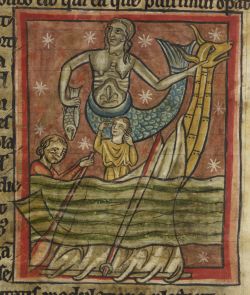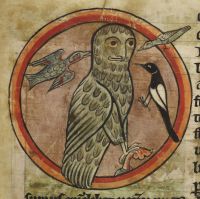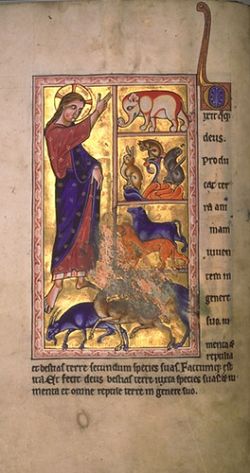The Medieval Bestiary: Difference between revisions
No edit summary |
|||
| (52 intermediate revisions by the same user not shown) | |||
| Line 1: | Line 1: | ||
[[File:Siren enchants sailors - Bestiary (1230-1240), f.47v - BL Harley MS 4751.jpg|thumb|250px|A siren enchants sailors with fish in hand while one sailor covers his ears. The Christian message regarding resisting temptations works quite well for the myth of the siren. From British Library, Harley MS 4751, Folio 47v]] | |||
In today’s globalized age, the internet grants access to a near infinite level of information. Yet in that vast wealth of knowledge, many people find themselves accessing it solely to look at cute animal pictures. This seemingly innate fascination with animals extends far back to the Middle Ages, wherein bestiaries were a popular genre. | In today’s globalized age, the internet grants access to a near infinite level of information. Yet in that vast wealth of knowledge, many people find themselves accessing it solely to look at cute animal pictures. This seemingly innate fascination with animals extends far back to the Middle Ages, wherein bestiaries were a popular genre. | ||
Simply put, a bestiary is a compendium of animals. In medieval bestiaries (many of which draw from the [https://en.wikipedia.org/wiki/Physiologus Physiologus] | Simply put, a bestiary is a compendium of animals. In medieval bestiaries (many of which draw from the [https://en.wikipedia.org/wiki/Physiologus Physiologus], each animal’s entry included things like etymological information, natural history, observations, habitats, and often wildly inaccurate [https://en.wikipedia.org/wiki/Illuminated_manuscript illuminations]. While somewhat analogous to a zoological encyclopedia, bestiaries were hardly scientific.<ref>David S. Lindberg, ''The Beginnings of Western Science'', University of Chicago Press, pp. 350-3 (1992), Retrieved 2020-12-02.</ref> Each description was usually a Christian allegory or comparison to guide the reader’s morality; nor was any of the information itself guaranteed to be true to reality. For example, as a puppy’s tongue can supposedly cure internal wounds, someone’s sins can be cleansed by a priest in [https://en.wikipedia.org/wiki/Confession_(religion)#Christianity) confession].<ref>''[https://www.abdn.ac.uk/bestiary/ms24/f19v Aberdeen Bestiary]'', Aberdeen University, folio 19v, Retrieved 2020-12-02.</ref>. On top of this, there are many entries for mythological creatures, such as dragons, phoenixes, and [https://en.wikipedia.org/wiki/Jaculus jaculi], which are listed alongside real animals as if to make their existence more credible. As for whether bestiaries were taken seriously by medieval people, there seems to be no consensus among scholars. While some have posited no, due to the presence of 13th century bestiary satire, others have noted that [https://en.wikipedia.org/wiki/Augustine_of_Hippo St. Augustine of Hippo's] reluctant acceptance of beast tales would have made them more believable to medieval Christians.<ref>Willene B. Clark and Meradith T. McMunn, ''Beasts and birds of the Middle Ages : the bestiary and its legacy'', University of Pennsylvania Press, pp. 5-6 (1989), retrieved 2020-12-02.</ref><ref>Philip Schaff. ''NPNF1-02. St. Augustine's City of God and Christian Doctrine'', CCEL, 1890. Retrieved 2020-12-10.</ref> | ||
This article will | This article will detail two large resources in the digital humanities concerning the medieval bestiary. | ||
== The Medieval Bestiary: Animals in the Middle Ages == | == The Medieval Bestiary: Animals in the Middle Ages == | ||
[http://bestiary.ca/ The Medieval Bestiary: Animals in the Middle Ages] is the most robust resource for bestiaries on the web. An independent project from Canadian scholar David Badke, this website collates information regarding “any and all aspects” of the topic “animals in the Middle Ages” with a focus on Western European manuscript tradition. The website contains a myriad of features and catalogues, which can be ordered in a variety of different ways. | [http://bestiary.ca/ The Medieval Bestiary: Animals in the Middle Ages] is the most robust resource for bestiaries on the web. An independent project from Canadian scholar David Badke, this website collates information regarding “any and all aspects” of the topic “animals in the Middle Ages” with a focus on Western European manuscript tradition. The website contains a myriad of features and catalogues, which can be ordered in a variety of different ways. Additionally, Badke runs an informal blog on the site titled Chimaera, a more informal affair where he details his own opinions and site notes. Although the site is mostly curated by Badke himself, many contributions come from readers. Sadly, the site has not been updated fully since 2011, but it still has proven to be an invaluable source for medieval scholars studying animals with its vast catalogue and detailed annotations and bibliography. Even a non-scholarly audience can appreciate a deep look into the history of animal depictions. | ||
Most notably, a user can access an index of all beasts that appear in bestiaries and other related works, which can be sorted alphabetically by the beasts’ common names or by cross referencing name variations (such as alternate names, spellings, and Latin names). Next to each beast on the list, the type of beast is shown, plus a short descriptor. Each entry contains a short summary of the beast’s general attributes, translated entries from the medieval texts in which the beast appears, a gallery of its artistic renderings, as well as a bibliography. | |||
=== Beast Index === | |||
[[File:Owl mobbed by smaller birds BL Harley MS 4751.jpg|thumb|200px| An illustration of an owl being attacked by smaller birds. Since owls are nocturnal and hide from the light, they represent how one should not look to the "glory of human praise." From British Library, Harley MS 4751, Folio 47r]] | |||
Most notably, a user can access an index of all [http://bestiary.ca/beasts.htm beasts] that appear in bestiaries and other related works, which can be sorted alphabetically by the beasts’ common names or by cross referencing name variations (such as alternate names, spellings, and Latin names). Next to each beast on the list, the type of beast is shown, plus a short descriptor. Each entry contains a short summary of the beast’s general attributes, translated entries from the medieval texts in which the beast appears, a gallery of its artistic renderings, as well as a bibliography. Emphasis is placed on comparing descriptions across bestiaries and synthesizing disparate depictions of animals into a cohesive narrative. A point is also made to explain artistic choices in the illustrations, including problematic ones such as the owl's hooked nose representing a Jewish stereotype (see image to the right).<ref>[http://bestiary.ca/beasts/beast245.htm Owl], The Medieval Bestiary, Retrieved 2020-12-10.</ref> | |||
=== Other Indexes === | |||
In addition to an index of beasts, the site also offers many other indexes of note: | |||
* An index of manuscripts of many different types (such as aviaries, [https://en.wikipedia.org/wiki/Psalter psalters], etc.) which can be sorted by the institute in possession of them, shelfmarks, or city where they are currently located. One can also categorize them by bestiary “family” or author. | |||
* An index of the site’s complete bibliography which can be sorted by author or subject. Many of the sources are annotated as well. | |||
* An encyclopedia of articles related to bestiaries and “animals in the Middle Ages,” which mostly contains articles on various medieval people who have “contributed to medieval animal lore.” | |||
* A Digital Text Library that collects PDF files from books and articles pertaining to medieval animals that are out of print and difficult to find. | |||
== Aberdeen Bestiary Project == | |||
[[File:Aberdeen bestiary.jpg|thumb|250px| God creates the animals as per Genesis 1:24-25. The gold coat is a prime example of the lavishness of the Aberdeen Bestiary. [https://www.flickr.com/photos/jpickens/7286068948/in/photostream/ "046 - The Aberdeen Bestiary, folio2verso" by Jennifer Pickens is licensed under CC BY-NC-ND 2.0]]] | |||
The [https://www.abdn.ac.uk/bestiary/ Aberdeen Bestiary Project] is a fully digitized and online version of the [https://en.wikipedia.org/wiki/Aberdeen_Bestiary Aberdeen Bestiary] (named after Aberdeen University which currently houses the text), a famous example of a bestiary due to its extravagant and expensive illustrations, as well as the high quality materials from which it is constructed. The website contains a fully scanned version of the text, with a total of over 300 high resolution images taken with special cameras and cradle to minimize heat and handling damage. These highly detailed images allow the full visual splendor of the illuminations to come across on screen without the need to see the text in person. | |||
Starting with the story of [https://en.wikipedia.org/wiki/Book_of_Genesis Genesis], the Aberdeen Bestiary details the stories and subsequent lessons to be learned from God’s creations: from animals, to trees and plants, parts of the human body, and finally various types of stones like jasper and sapphire. Each folio can be viewed individually or in a book view to mimic an open codex with a variety of image options such as zooming or panning. Below each image also contains a short commentary that summarizes the page’s contents and a full Latin transcription and translation side by side. | |||
The website also contains detailed descriptions on the history of the Aberdeen Bestiary manuscript specifically, the bestiary genre as a whole, and an extensive section on [https://en.wikipedia.org/wiki/Codicology codicology], the study of codices, with visual examples of codex elements from the text itself. This section includes analyses of preliminary sketches in the margins, ruling, [https://en.wikipedia.org/wiki/Rubrication rubrication], glosses, and handwriting among other topics which reveal a great deal about the manuscript's production, history, and how it was used in its day. | |||
== | == References == | ||
Latest revision as of 04:20, 11 December 2020

In today’s globalized age, the internet grants access to a near infinite level of information. Yet in that vast wealth of knowledge, many people find themselves accessing it solely to look at cute animal pictures. This seemingly innate fascination with animals extends far back to the Middle Ages, wherein bestiaries were a popular genre.
Simply put, a bestiary is a compendium of animals. In medieval bestiaries (many of which draw from the Physiologus, each animal’s entry included things like etymological information, natural history, observations, habitats, and often wildly inaccurate illuminations. While somewhat analogous to a zoological encyclopedia, bestiaries were hardly scientific.[1] Each description was usually a Christian allegory or comparison to guide the reader’s morality; nor was any of the information itself guaranteed to be true to reality. For example, as a puppy’s tongue can supposedly cure internal wounds, someone’s sins can be cleansed by a priest in confession.[2]. On top of this, there are many entries for mythological creatures, such as dragons, phoenixes, and jaculi, which are listed alongside real animals as if to make their existence more credible. As for whether bestiaries were taken seriously by medieval people, there seems to be no consensus among scholars. While some have posited no, due to the presence of 13th century bestiary satire, others have noted that St. Augustine of Hippo's reluctant acceptance of beast tales would have made them more believable to medieval Christians.[3][4]
This article will detail two large resources in the digital humanities concerning the medieval bestiary.
The Medieval Bestiary: Animals in the Middle Ages
The Medieval Bestiary: Animals in the Middle Ages is the most robust resource for bestiaries on the web. An independent project from Canadian scholar David Badke, this website collates information regarding “any and all aspects” of the topic “animals in the Middle Ages” with a focus on Western European manuscript tradition. The website contains a myriad of features and catalogues, which can be ordered in a variety of different ways. Additionally, Badke runs an informal blog on the site titled Chimaera, a more informal affair where he details his own opinions and site notes. Although the site is mostly curated by Badke himself, many contributions come from readers. Sadly, the site has not been updated fully since 2011, but it still has proven to be an invaluable source for medieval scholars studying animals with its vast catalogue and detailed annotations and bibliography. Even a non-scholarly audience can appreciate a deep look into the history of animal depictions.
Beast Index

Most notably, a user can access an index of all beasts that appear in bestiaries and other related works, which can be sorted alphabetically by the beasts’ common names or by cross referencing name variations (such as alternate names, spellings, and Latin names). Next to each beast on the list, the type of beast is shown, plus a short descriptor. Each entry contains a short summary of the beast’s general attributes, translated entries from the medieval texts in which the beast appears, a gallery of its artistic renderings, as well as a bibliography. Emphasis is placed on comparing descriptions across bestiaries and synthesizing disparate depictions of animals into a cohesive narrative. A point is also made to explain artistic choices in the illustrations, including problematic ones such as the owl's hooked nose representing a Jewish stereotype (see image to the right).[5]
Other Indexes
In addition to an index of beasts, the site also offers many other indexes of note:
- An index of manuscripts of many different types (such as aviaries, psalters, etc.) which can be sorted by the institute in possession of them, shelfmarks, or city where they are currently located. One can also categorize them by bestiary “family” or author.
- An index of the site’s complete bibliography which can be sorted by author or subject. Many of the sources are annotated as well.
- An encyclopedia of articles related to bestiaries and “animals in the Middle Ages,” which mostly contains articles on various medieval people who have “contributed to medieval animal lore.”
- A Digital Text Library that collects PDF files from books and articles pertaining to medieval animals that are out of print and difficult to find.
Aberdeen Bestiary Project

The Aberdeen Bestiary Project is a fully digitized and online version of the Aberdeen Bestiary (named after Aberdeen University which currently houses the text), a famous example of a bestiary due to its extravagant and expensive illustrations, as well as the high quality materials from which it is constructed. The website contains a fully scanned version of the text, with a total of over 300 high resolution images taken with special cameras and cradle to minimize heat and handling damage. These highly detailed images allow the full visual splendor of the illuminations to come across on screen without the need to see the text in person.
Starting with the story of Genesis, the Aberdeen Bestiary details the stories and subsequent lessons to be learned from God’s creations: from animals, to trees and plants, parts of the human body, and finally various types of stones like jasper and sapphire. Each folio can be viewed individually or in a book view to mimic an open codex with a variety of image options such as zooming or panning. Below each image also contains a short commentary that summarizes the page’s contents and a full Latin transcription and translation side by side.
The website also contains detailed descriptions on the history of the Aberdeen Bestiary manuscript specifically, the bestiary genre as a whole, and an extensive section on codicology, the study of codices, with visual examples of codex elements from the text itself. This section includes analyses of preliminary sketches in the margins, ruling, rubrication, glosses, and handwriting among other topics which reveal a great deal about the manuscript's production, history, and how it was used in its day.
References
- ↑ David S. Lindberg, The Beginnings of Western Science, University of Chicago Press, pp. 350-3 (1992), Retrieved 2020-12-02.
- ↑ Aberdeen Bestiary, Aberdeen University, folio 19v, Retrieved 2020-12-02.
- ↑ Willene B. Clark and Meradith T. McMunn, Beasts and birds of the Middle Ages : the bestiary and its legacy, University of Pennsylvania Press, pp. 5-6 (1989), retrieved 2020-12-02.
- ↑ Philip Schaff. NPNF1-02. St. Augustine's City of God and Christian Doctrine, CCEL, 1890. Retrieved 2020-12-10.
- ↑ Owl, The Medieval Bestiary, Retrieved 2020-12-10.